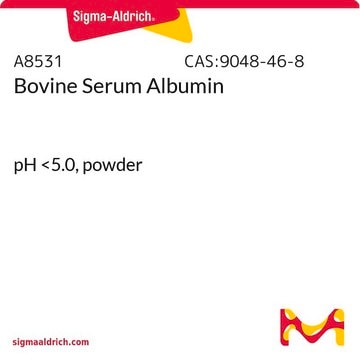1.15444
Coomassie Brilliant blue G 250 (C.I. 42655)
for electrophoresis
別名:
Coomassie Brilliant blue G 250 (C.I. 42655), Acid blue 90, Brilliant Blue G, Cyanine G, Polar Blue G, SERVA BLUE G, protein gel stain
About This Item
おすすめの製品
品質水準
有効性
>5000 mg/kg LD50, oral (Rat)
テクニック
protein staining: suitable
pH
6.4 (20 °C, 10 g/L in H2O)
溶解性
40 g/L
かさ密度
520 kg/m3
保管温度
no temp limit
InChI
1S/C47H49N3O7S2.Na/c1-6-49(31-35-11-9-13-43(29-35)58(51,52)53)40-21-25-45(33(4)27-40)47(37-15-17-38(18-16-37)48-39-19-23-42(24-20-39)57-8-3)46-26-22-41(28-34(46)5)50(7-2)32-36-12-10-14-44(30-36)59(54,55)56;/h9-30,48H,6-8,31-32H2,1-5H3,(H-,51,52,53,54,55,56);/q;+1/p-1
InChI Key
CMGWKYXJIYYESN-UHFFFAOYSA-M
詳細
アプリケーション
アナリシスノート
Absorption maximum λmax. (buffer pH 7.0): 577 - 584 nm
Spec. Absorptivity A 1%/1cm (λmax; 0.01 g/l; buffer pH 7.0; calc. on dried substance): 450 - 570
TLC-Test: passes test
Loss on drying (110 °C): ≤ 8 %
Suitability for electrophoresis: passes test
法的情報
保管分類コード
11 - Combustible Solids
WGK
WGK 3
引火点(°F)
Not applicable
引火点(℃)
Not applicable
試験成績書(COA)
製品のロット番号・バッチ番号を入力して、試験成績書(COA) を検索できます。ロット番号・バッチ番号は、製品ラベルに「Lot」または「Batch」に続いて記載されています。
この製品を見ている人はこちらもチェック
資料
SDS-PAGE(ドデシル硫酸ナトリウム-ポリアクリルアミドゲル電気泳動)用のサンプルの調製および電気泳動条件の最適化の際に生じる課題と、その考えられる原因および対応策を示します。
Identify causes and remedies for SDS-PAGE sample preparation challenges and optimize electrophoresis conditions.
ライフサイエンス、有機合成、材料科学、クロマトグラフィー、分析など、あらゆる分野の研究に経験のあるメンバーがおります。.
製品に関するお問い合わせはこちら(テクニカルサービス)








